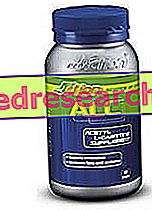Generality
Fresh cream is a food very rich in lipids (around 35%), obtained from cow's milk. It represents one of the three types of "cream of milk" (animal) marketed in Italy; the other two are coffee cream and cooking cream. Being pasteurized, compared to the kitchen equivalent, fresh cream CANNOT be stored for a long time and has a limited shelf-life (of a few days).

Fresh cream is ideal for whipping (high whippeability ); not undergoing any substantial chemical-physical modification, attributable to the thermal or conservative treatment, the fresh cream proteins guarantee an excellent consistency of the foam. The latter also, thanks to the high lipid content of fresh cream (about 35%), makes use of a remarkable stability.
The main difference between the fresh cream, the cooking cream and the coffee cream from the cafeteria consists precisely in the predisposition to the frame.
Video Recipe - Learn how to make vegetable cream at home
The nutritional profile of milk cream, whatever it is, depends essentially on the method of obtaining fat. First of all, it can be observed that the fresh cream, compared to the others (above all the cream of milk for cafeteria) possesses a greater lipid fraction, to which contrasts a lower content of serum and water-soluble molecules (water, lactose, water-soluble vitamins and mineral salts); then, looking at the ratio of lipofie molecules, a certain difference emerges in the partial quantities of glycerides.
| TYPE OF CREAM | % fat |
| According to the Circular of the Ministry of Health (n.40 / 1974) * | |
| Coffee cream | ≥ 10% |
| Cooking cream | ≥ 20% |
| Whipping cream or for pastry | ≥ 30% |
| Other types of Commercial Cream | |
| Double cream | ≥ 48% |
By the same principle, the total bacteriological charge and the types of microorganisms involved also vary considerably (just think that the outcrop is applied to raw milk left RIPOSARE, a time in which certain bacteria have time to replicate).
We recall that the physical state of fresh cream (and other types of cream) varies substantially depending on the temperature. Triglycerides are always liquids at + 40 ° C, while they crystallize at -18 ° C; the viscosity and stability are therefore proportional to the lowering of the temperature.
* The cream cannot contain any chemical additives, however for the "whipped cream" it is possible to use non-toxic gases as propellants.
Why does fresh cream fit?
We try to explain in completely comprehensible terms how the fresh cream is assembled.
Fresh cream is a suspension-solution of water, fats, proteins, minerals and vitamins. By mixing and shaking the liquid (eg by means of a kitchen whisk) a combination of casein proteins takes place, with relative entrapment of air bubbles. This protein lattice, which should be potentially unstable, is consolidated by the presence of fat globules that adhere to the proteins themselves. Ultimately, fresh cream is the only one to be set up for the frame as it uses:
- intact casein proteins (instead gelled in cooking cream due to UHT treatment);
- a quantitatively suitable lipid portion (greater than the cream from the kitchen and even more than the cream of milk from the cafeteria).
Unlike kitchen cream, the fresh one does not contain additives.
Purpose of fresh cream in gastronomy
From the ingredients used for the trade of fresh cream it is also possible to obtain butter; this, however, is of superior quality if it is obtained from the fat portion obtained by centrifugation, since the surfacing technique implies an excessive bacterial proliferation with an increase in total acidity.
Video Recipe - Find out how to make homemade butter from fresh cream
Fresh cream is an ingredient widely used both in pastry (sweet and savory), and in the kitchen. When it is not intended for mounting, it can be replaced by cooking cream (although the taste may be slightly different).
Fresh cream is exploited due to the presence of fat; these, which we remember to be greater than the coffee cream and coffee cream can have different effects depending on the recipe in which they are added. In sauces and sauces, fresh cream promotes creaminess, homogenization of taste and overall palatability; among other things, the use of fresh cream allows any excesses of salt or spices to be corrected and gives a lighter color. Inside the leavened cakes, fresh cream increases softness and maintains the softness of the dough for a longer time.
List Video Recipes based on Fresh Cream
| Nutritional composition of cream or milk cream - Reference values of INRAN Food Composition Tables | ||||||||||||||||||||||||||||||||||||||||||||||||||||||||||||||||||||||||
 | ||||||||||||||||||||||||||||||||||||||||||||||||||||||||||||||||||||||||
Nutritional values (per 100 g of edible portion) | ||||||||||||||||||||||||||||||||||||||||||||||||||||||||||||||||||||||||
| ||||||||||||||||||||||||||||||||||||||||||||||||||||||||||||||||||||||||
Sometimes the fresh cream is replaced by the use of whole milk; although it may seem to be a good choice (for the reduction of overall lipids), we recall that milk has a greater tendency to coagulate and separate in the presence of heat and acidic components. On the other hand, excessive use of fresh cream tends to mask the flavor of the recipe and, in the most extreme cases, makes preparations that are very different from each other too similar.
In the pastry sector, fresh cream is used in many ways for many recipes. Liquid is added to the mixtures (eg panna cotta), but also whipped (eg semifreddi), sweetened or natural.
Nutritional composition of fresh cream
Fresh cream is a very caloric food (therefore unsuitable for a slimming diet) due to its high triglyceride content; these, consisting predominantly of saturated fatty acids, in association with the abundant presence of cholesterol, make fresh cream a food not suitable for feeding against hypercholesterolemia.
Also remember that fresh cream has a portion of serum in which are dissolved: proteins, salts, water-soluble vitamins MA also lactose (glucides). The latter nutrient may be subject to adverse reactions in subjects with specific and diagnosed food intolerance.
As far as mineral salts are concerned, fresh cream contains calcium and phosphorus (typical of milk) even if, being ions soluble in water, their presence is certainly not the highest. With regard to vitamins, the liposoluble ones of group A (retinol equivalents) stand out.
Recall that fresh cream is a derivative of milk to be considered as a condiment fat; its use, if sporadic, can be compensated by reducing the oil supply, even if, from a nutritional point of view, this could lead to a reduction of the healthiest fatty acids for the body in favor of the hypercholesterolemic ones.



